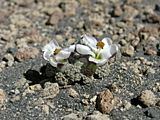
1 -
Pinus cembra
Evergreen
Pinus cembra
has a hard time in late winter, when exposed to bright sun with zero
photosynthetic activity due to cold temperatures. However, a suite of
physiological-biochemical changes associated with winter dormancy protects
plants. A visible indication of this adjustment is the yellow appearance of
needles. Other species as for instance
Larix decidua
(larch, in the background) avoid such problems by shedding their leaves in
autumn. With this strategy, they can grow in the coldest place on earth, in
sub-polar western Siberia.
1 -
A lot of sun, while metabolism is blocked by low temperatures increases the
risk of
phototoxicity (Central Alps).

2 -
Rumex alpinus
emerging from snow in spring.
2 -
Risk of "sun burn": Snow melt in spring (Central Alps).

3 -
Nototriche turritella, here at 4200 m in the
Bolivian altiplano resists extremely intense
solar radiation and 8 months without rain (total
c. 300 mm a-1)
by narrow, highly pubescent
(reflective) leaves and a massive and deep tap
root (picture taken during the rainy season in
February).
3 -
Combination of high radiation and drought (Bolivian Altiplano, 4200 m).
Green plants need solar radiation, but at times, there may be too much of it.
Radiation can be in excess of tolerable intensity
-
when the photosynthetic machinery is not prepared to use any photons
-
when plants are suddenly exposed to high radiation without enough time for
acclimation
The worst case is the combination of the two, as can happen at sudden a release
from snow cover.
Whenever leaf pigments absorb photons but have no use for them (e.g. at low
temperatures, upper photograph) this energy needs to be dissipated without
harming the whole machinery (e.g. by re-emitting the energy in the form of
fluorescence or warmth), otherwise phototoxicity does occur. Mountain plants
are perfectly equipped for such situations and therefore photodamage by visible
light is a very rare phenomenon. In order to avoid such situations, rapidly
emerging plants (as shown in the lower photograph) lack chlorophyll initially
and are packed with protective compounds (see UV-B).



